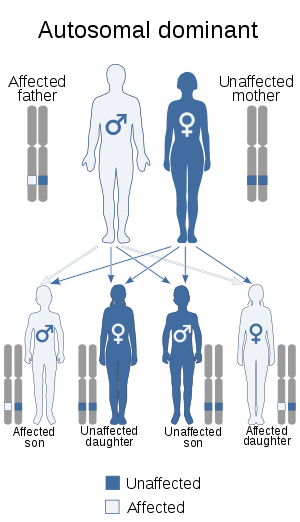Wunderlich syndrome
| Wunderlich syndrome | |
|---|---|
 | |
| This condition is inherited in an autosomal dominant manner |
Wunderlich syndrome is spontaneous, nontraumatic renal hemorrhage confined to the subcapsular and perirenal space. It may be the first manifestation of a renal angiomyolipoma (AML), or rupture of renal artery or intraparechymal aneurysm.[1]
Diagnosis
First symptoms may be subtle such as mild pain, flank tenderness, haematuria. Depending on blood loss, symptoms of hypovolemic shock may develop. Hematoma is usually contained in the retroperitoneum, allowing for a period of haemodynamic stability. Sometimes massive acute hemorrhage is seen when a hematoma ruptures Gerota's fascia and extends into the peritoneum. An ultrasound or CT scan can establish diagnosis, while lab tests may be inconclusive as changes of haematocrit or haemoglobin are not specific to the syndrome, while haematuria is not always present.
Treatment
Treatment varies according to severity, ranging from monitoring of the hematoma (in haemodynamic stability) to emergency surgery (when patients develop hypovolemic shock requiring seminephrectomy or nephrectomy). Vascular causes lead to surgery due to severity of hemorrhage. Robotic-assisted partial nephrectomy has been proposed as a surgical treatment of a ruptured angiomyolipoma causing retroperitoneal hemorrhage, combining the advantages of a kidney preservation procedure and the benefits of a minimally invasive procedure without compromising the safety of the patient.[2]
References
- ↑ "A Cough Deteriorating Gross Hematuria: A Clinical Sign of a Forthcoming Life-Threatening Rupture of an Intraparenchymal Aneurysm of Renal Artery (Wunderlichs Syndrome)". Case Reports in Vascular Medicine. 2013: 1–3. doi:10.1155/2013/452317.
- ↑ Ploumidis A, Katafigiotis I, Thanou M, Bodozoglou N, Athanasiou L, Ploumidis A (2013). "Spontaneous Retroperitoneal Hemorrhage (Wunderlich Syndrome) due to Large Upper Pole Renal Angiomyolipoma: Does Robotic-Assisted Laparoscopic Partial Nephrectomy Have a Role in Primary Treatment?". Case Rep Urol. 2013: 498694. doi:10.1155/2013/498694. PMC 3784227. PMID 24106637.
- Albi G, Campo L, Tagarro D (Sep 2002). "Wünderlich's syndrome: causes, diagnosis and radiological management". Clin Radiol. 57 (9): 840–5. doi:10.1016/s0009-9260(02)90981-5. PMID 12384111.
External links
| Classification | |
|---|---|
| External resources |